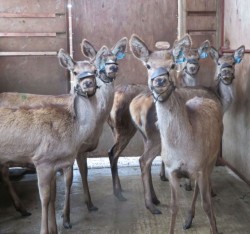Aug 21, 2023
Research in Scotland has identified tannin-rich heather as a methane reducer in wild deer, pointing the way to new greenhouse gas (GHG) research for New Zealand’s farmed deer.
The Scottish research is highlighted in a deer-specific methane mitigation literature review, just completed as part of the DINZ/AgResearch-funded Science4Success programme.

This AgResearch Invermay R1 mob was successfully acclimatised over time for halters, ready for potentially measuring methane outputs.
In the early 2000s, New Zealand researchers hypothesised that tannin-rich feeds could be a potential mitigation tool for deer and the research from Pérez-Barberīa et al, published in Science of the Total Environment 2020, has confirmed that, notes DINZ policy and research manager Emil Murphy.
“Our task is now to package that knowledge up to contribute to the profitability of deer farming,” he says.
Scientific publications from around the world were searched for deer-specific information quantifying methane emissions from deer, especially farmed deer. While not much was found, and the majority relating to farmed deer was sourced from New Zealand, this was summarised.
Murphy is now considering its recommendations for the deer industry’s ongoing GHG mitigation research programme. These include looking into tannin-rich feeds – such as plantain, chicory and birdsfoot trefoil forages, already used in New Zealand farmed deer production – methane outputs by age, sex, breed or other factors, investigation of deer rumen microbial populations and planning for genetic selection.
“It is really important for us to have farmed deer-specific information to hand, to help farmers calculate their on-farm emissions accurately and plan their mitigations,” he says.
While the Ministry for the Environment already recognises the differences in methane output from deer, ranking it halfway between sheep and cattle in its calculations, “it doesn’t recognise the unique biology of deer, explains Murphy.
“It is likely that the methane conversion rate (MCR) for deer in the National Inventory could be lowered,” the review suggests.
Other research just getting underway in the Science4Success methane pipeline includes a year-long methane-linked project looking at deer temperament and feed utilisation by Lincoln University PhD student Ella Wilson. Work will also soon start on “the gold standard for measuring methane emissions”, deer-specific respiration chambers.
This all builds on work already done on estimating deer methane emissions and the deer-industry-funded work since 2003 through the Pastoral Greenhouse Gas Research Consortium (PGgRC). The PGgRC funding has developed much of the world-leading understanding of the underlying biology of methane production and management in ruminants.

